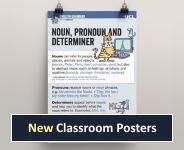Tense and aspect in fiction
In this activity we will examine some short extracts from novels. The idea is to look at the tense and aspect forms used, and think about how they are used to unfold the action of the story.
Goals
- Identify tense and aspect in highlighted verb phrases from real, published fiction.
- Discuss the effect on the reader of different tense and aspect in different extracts.
Lesson Plan
The teacher explains that today, we will look at verbs in fiction.
The Activity page appears in the menu entitled This Unit in the upper right corner of this page. The Activity page includes slides that can be displayed on a projector or smart board. Each slide presents a short extract from a work of fiction. Ask the students to do the following:
- First, identify the different tense and aspect combinations used in each of the marked verb phrases.
- Then, think about how these forms are used to tell the story: for instance, to set the scene or take the action forward.
Discussion
Slide 1
You might have noticed that the first two sentences set up a scene, and then the third sentence moves the action forward:
- There are two uses of the simple past tense verb was. One is used to set up the past time location (It was after supper) and the other gives Gus’s whereabouts (Gus was outside). These clauses describe states rather than activities or events, so they don't use the past progressive: we wouldn't write It was being after supper, or Gus was being outside. Similarly, we wouldn’t normally say She is being tall. Instead we would say She is tall to describe this state. We could say They are being naughty, but here we are talking about some ongoing temporary situation (they are doing something naughty right now, but they are not normally naughty).
- Several past progressive forms are used to describe ongoing activity (was reading and smoking, was playing patience and drumming ...). The clause checking on the dogs also describes an ongoing activity.
- We then have the past tense burst in Suddenly he burst in. This describes an event, something that happens suddenly, non-continuously, in a moment.
Slide 2
Here we first have two uses of the past tense to describe events taking place in quick succession (called, woke). When the aeronaut wakes up, he becomes aware of the situation ongoing around him. The next verb phrases help to describe this ongoing situation.
The past tense was helps to describe a state of affairs (something was wrong). Here we would not use a progressive: we wouldn’t write something was being wrong.
In the following main clauses, we have past progressives which describe ongoing events (was swinging, were barely managing) and create a dynamic image. There is a simple past (buffeted) in a subordinate clause. (We also have the nonfinite clause, pulling the rope, which describes an ongoing action by the witches.)
Slide 3
You probably identified the examples of past progressive (was speaking) and of simple past tense (remembered, walked). What is different here is the use of several instances of the past perfect: had pointed, had buried, ’d looked. These come after remembered and describe events that the narrator is remembering.
That means that the time frame shifts backwards instead of forwards:
- The speaking and remembering happen at a past time that the narrator is telling us about (with the remembering happening during the speaking).
- The other events happen further in the past, before the time of remembering. The passage doesn’t really spell out the ordering of all these events, but we can work out a likely order: perhaps burying, then pointing, then looking back while walking away?
Welcome!

Englicious is totally free for everyone to use!
But in exchange, we ask that you register for an account on our site.
If you’ve already registered, you can log in straight away.
Since this is your first visit today, you can see this page by clicking the button below.
- Printer-friendly version
- Log in to view or leave comments

